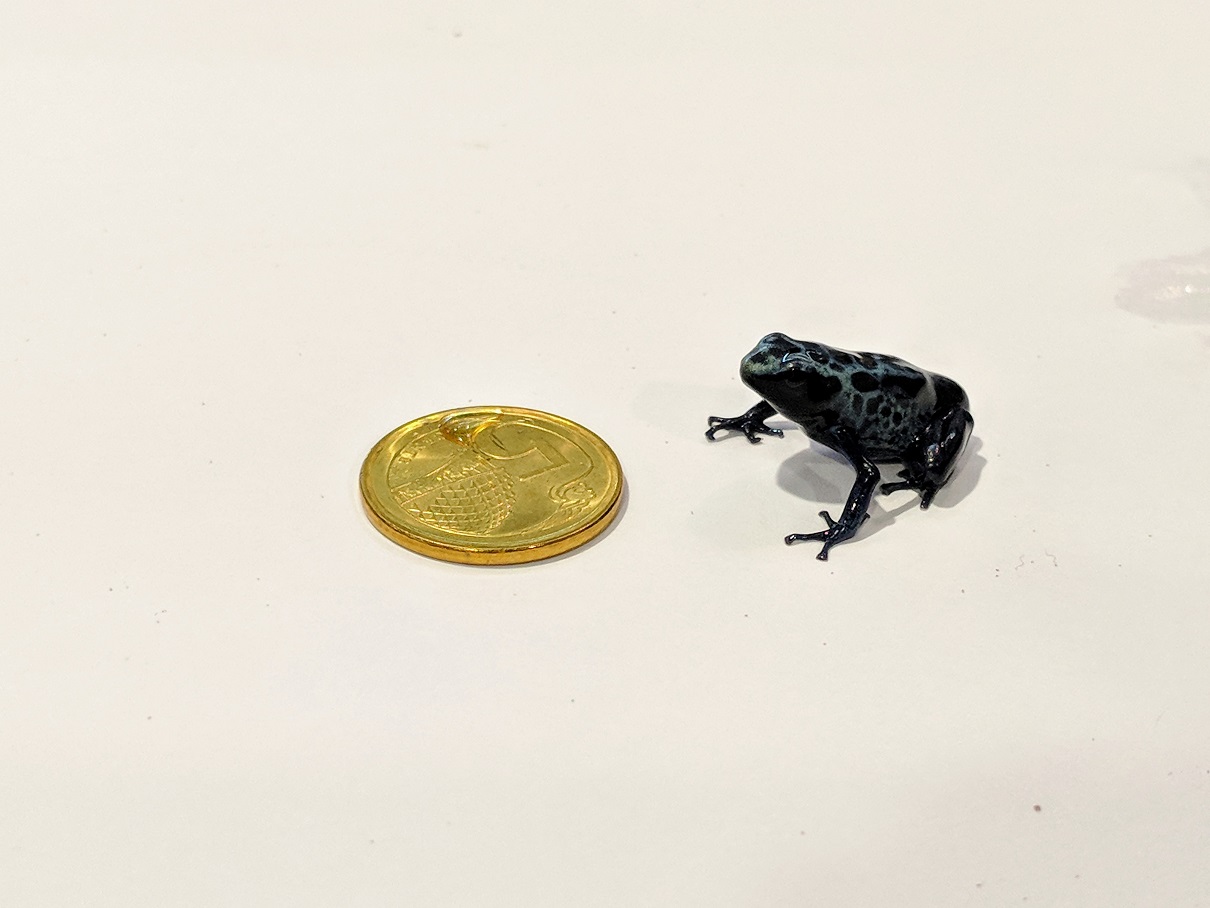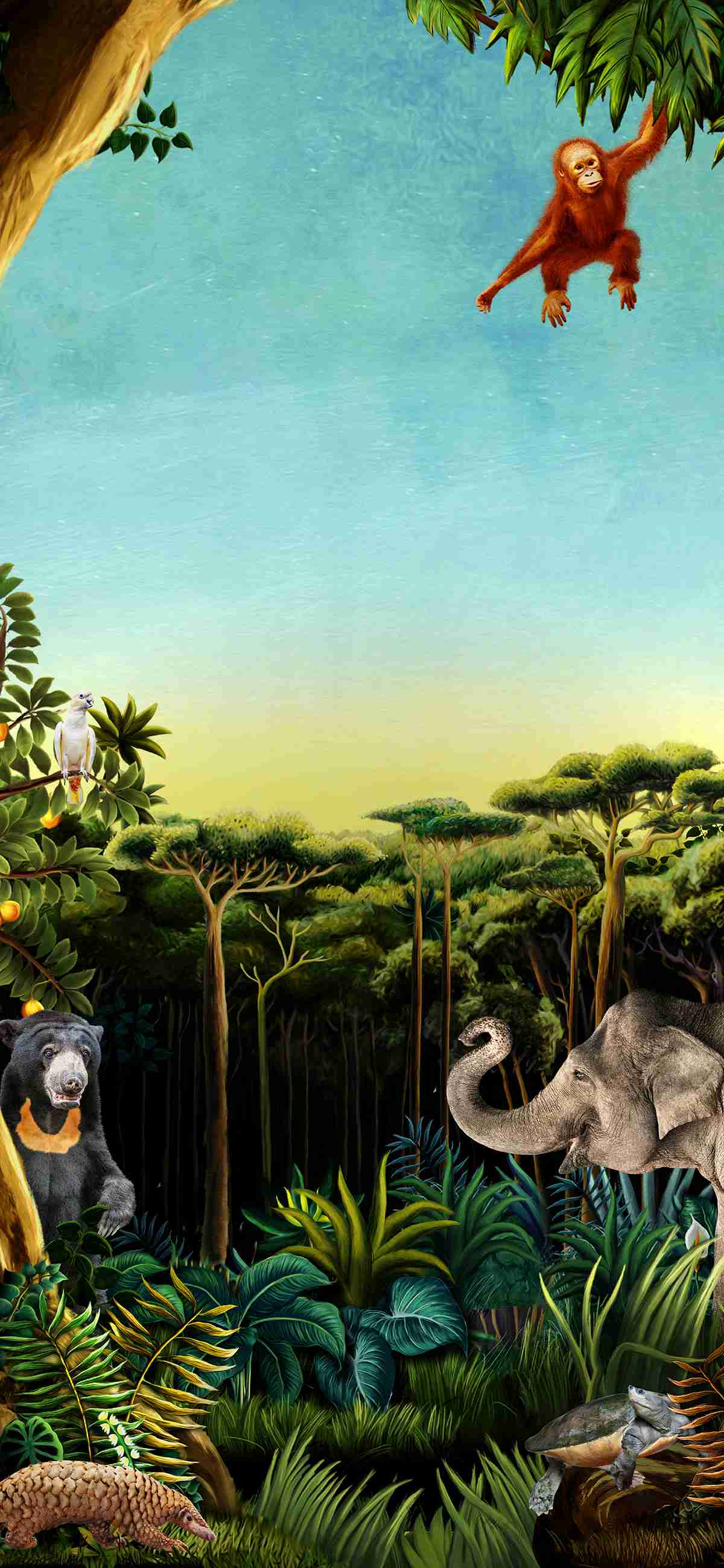Singapore Zoo's RepTopia marks first year with hefty haul of herpetological wonders
16 AUG 2018
Singapore Zoo’s newest exhibit, RepTopia saw 40 successful hatchings of the iconic Panther Chameleon. No larger than the head of a pen, these vulnerable hatchlings require diligent care from RepTopia’s keepers. Visitors can see them at RepTopia’s glass-fronted hatchery.
PHOTO CREDITS: WILDLIFE RESERVES SINGAPORE

Six Gaboon Vipers were born in RepTopia’s first year. Pictured with a Singapore dollar coin for scale, the young viper can potentially grow into a snake with the world’s longest fangs (at up to five centimetres) and the ability to deliver the most venom in a single bite. Visitors can see one of the young vipers on display at RepTopia’s glass-fronted hatchery.
PHOTO CREDITS: WILDLIFE RESERVES SINGAPORE
RepTopia’s resident reptiles and amphibians heralded the first year anniversary of Singapore Zoo’s state of the art exhibit focused on conservation, mixed-species display, and interactivity with a successful breeding boom of over 80 specimens across eight species.
The precious new arrivals include the exhibit’s iconic Panther Chameleon with 40 hatchlings and Gaboon Viper with six live births. Three of the eight successfully bred species in RepTopia are classified as threatened under the IUCN* Red List of Endangered Species–Electric Blue Geckos (critically endangered), Golden Poison Frogs (endangered) and Henkel’s Leaf-tailed Geckos (vulnerable).
New additions like the Panther Chameleon hatchlings are no larger than the head of a pen, and caring for such small animals posed big challenges for RepTopia’s animal care team. Samuel Tay, Head Keeper of the Herpetology section said, “In the wild, the chameleon’s reproduction strategy is to produce as many young as possible to make up for the high mortality. During their growth stages they are more sensitive to temperature and environmental changes so we need to be especially meticulous in monitoring, feeding and misting them to ensure that each individual is getting sufficient nutrients, hydration and heat to grow well.”
The successful hatching of six critically endangered Electric Blue Geckos made for healthy additions to the populations of the species under human care. Under threat by the illegal pet trade, Electric Blue Geckos only exist in small isolated areas in their home range of Tanzania. Other welcome additions were three tiny masters of disguises, the Henkel’s Leaf Tailed Gecko, classified as vulnerable in its native range of Madagascar.
Not to be outdone, RepTopia’s amphibians also leapt to the challenge, and produced nine Golden Poison Frogs in August, marking Singapore Zoo’s first successful attempt at breeding the endangered species. Four Dyeing Poison Frogs were also bred successfully. As tadpoles are remarkably vulnerable before metamorphosis, caring for them is no easy task and requires keepers to painstakingly maintain the optimal conditions for survival. They monitor the tadpole’s growth to ensure sufficient food is provided, tweak and adjust surrounding temperatures to promote growth, and clean their containers on a regular basis to ensure water quality.
Armed with the newly acquired knowledge and experience in breeding the poison dart frogs, the Herpetology team is ready to attempt breeding the rarer and trickier to breed critically endangered Golden Mantella. Frogs and other amphibians around the world are under threat from climate change, pollution and a highly contagious fungal disease that has wiped out many populations. In RepTopia, breeding them in controlled environments under the expert care of keepers contributes toward maintaining stable populations.
Visitors can see most of RepTopia’s babies at its glass-fronted hatchery but for a closer look, they may choose to go beyond the glass at RepTopia’s behind-the-scenes tour. Since its launch in the beginning of the year, close to 150 visitors have fed a Panther Chameleon from their palm and witnessed the snail-crushing jaws of the Caiman Lizard among other interactive opportunities at the exclusive tour programme.
Conducted by professional guides and highly skilled keepers trained to handle both reptiles and squeamish guests, the goal is to change negative perceptions and inculcate an appreciation for these often-misunderstood animals. By engaging guests in deeper and more meaningful wildlife experiences, the tour is another display of Singapore Zoo’s evolution from a viewing zoo to a learning zoo.
Dr Cheng Wen-Haur, Deputy Chief Executive Officer and Chief Life Sciences Officer, Wildlife Reserves Singapore, said, “Reptiles and amphibians are among the most threatened groups of animals on earth, with almost one-fifth of all reptiles and close to a third of all amphibians threatened with extinction. These animals have vital roles to play in maintaining healthy ecosystems and many of them are wonderful and amazing creatures in their own right. RepTopia was created to bring our guests closer to these remarkable creatures and to join us in our efforts to save them from extinction.”
A Panther Chameleon hatchling being fed water from a probe. With 40 Panther Chameleon hatchlings to care for at their most vulnerable stage of their life, RepTopia’s keepers have to maintain a rigorous routine of careful observation, feeding and providing hydration to ensure that each individual is growing well.
PHOTO CREDITS: WILDLIFE RESERVES SINGAPORE

Feeding a Panther Chameleon from your palm is one of several interactive elements of the RepTopia behind-the-scenes tour. By engaging guests with animal interactions, the tour aims to change negative perceptions and inculcate a sense of appreciation for reptiles and amphibians.
PHOTO CREDITS: WILDLIFE RESERVES SINGAPORE

Starting out at no more than a few centimetres long, the hatchling has some serious growing to do. Adult males can measure about 40cm and have vibrant colour patterns while females tend to be smaller and less colourful. Despite common belief that Chameleons change colour to blend in with their surroundings, which can happen at times, the most common cause for the colour changes are changes in their temperature and in their general disposition, and each species has their specific colour change patters that signal stress, readiness to mate and aggressions or submission.
PHOTO CREDITS: WILDLIFE RESERVES SINGAPORE

Three Henkel’s Leaf-tailed Geckos were hatched in RepTopia. The hatchling already has its signature fringe of skin edging its head and body that enables it to blend into
tree trunks by breaking up the outline of its body. The species is vulnerable in its native range of Madagascar due to habitat loss and illegal trade.
PHOTO CREDITS: WILDLIFE RESERVES SINGAPORE

Six critically endangered Electric Blue Geckos have been successfully bred in RepTopia. No larger than a Singapore dollar coin, this young gecko will grow but not by much. Adult Electric Blue Geckos average not more than five to eight centimetres. Juvenile and female electric blue geckos are green, while adult males sport the signature shade of electric blue. This beautiful species is found only in a very small area of unprotected Pandanus forest in Tanzania, and has suffered tremendously from habitat degradation and illegal poaching.
PHOTO CREDITS: WILDLIFE RESERVES SINGAPORE

RepTopia welcomed two Knob-tailed Gecko hatchlings. The peculiar looking lizard is native to Australia, and has a small tail with a knob at the end, hence its name. The RepTopia team is particularly proud to have successfully bred these given their notorious difficulty in breeding under human care.
PHOTO CREDITS: WILDLIFE RESERVES SINGAPORE
Twenty one Plumed Basilisks have successfully hatched in RepTopia. The young lizard still lacks the iconic head crest of the adult. With its amazing ability to run on water over short distances, the Plumed Basilisk has earned itself a most interesting name, the “Jesus Christ lizard”.
PHOTO CREDITS: WILDLIFE RESERVES SINGAPORE

A recently metamorphosed Dyeing Poison Frog (left) and adult (right). The froglet is no larger than a Singapore five-cent coin. Its adult form is noticeably bigger but still relatively small at about three to four-and-a-half centimetres in length.
PHOTO CREDITS: WILDLIFE RESERVES SINGAPORE
A recently metamorphosed Golden Poison Frog (left) and adult (right). In a first for Singapore Zoo, nine Golden Poison Frogs were successfully bred in RepTopia.The young frog will eventually lose its dark colouration and take on the greenish hue of the adult. Golden Poison Frogs may vary from yellow, orange and mint-green depending on their colour morphs. Golden Poison Frogs are endangered in their home range of Colombia. Wild frogs are known to absorb toxins from their diet and deposit them in their skin; one single wild Golden Poison Frog has enough toxin to kill 10 grown men. Specimens bred under human care are fed a captive diet and are non-toxic.
PHOTO CREDITS: WILDLIFE RESERVES SINGAPORE

